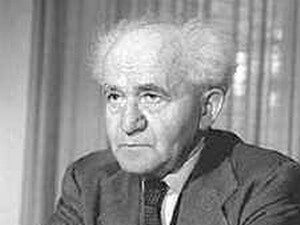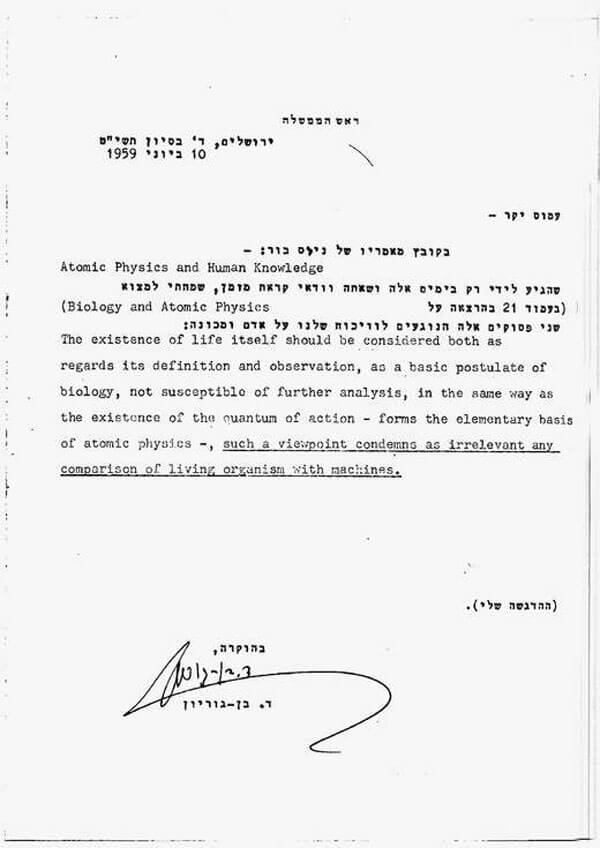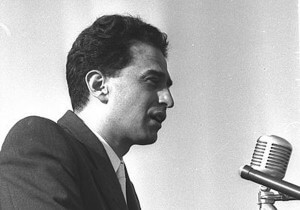An exchange of letters between the first prime minister and Prof. Amos de Shalit, one of the most important scientists in Israel at the beginning of the country, sheds light on what the "old man" thought about computing and technology

There was a prime minister who liked to read popular science books and draw authority from them. David Ben-Gurion, who chose a scientist (Weizmann) for the position of the first president and offered another scientist (Einstein) the position of the second president, was very interested in scientific issues and in particular in the question of artificial intelligence.
This week, on the occasion of National Science Day, the IDF Archives published three letters from a selection of letters from the first Prime Minister, David Ben-Gurion, and Prof. Amos de Shalit, one of the most important scientists in Israel at the beginning of the state.
The letters, Ben-Gurion's from June 10, 1959, De-Schlit's reply from July 3 and Ben-Gurion's response from July 27, deal with the question of whether machines can think like humans. It turns out that at the same time Ben-Gurion read Niels Bohr's book (the father of quantum theory) Atomic Physics and Human Knowledge and two paragraphs from it concerned the debate between Ben-Gurion and de Schlit. Ben-Gurion doubted the computer's ability to surpass man, de Schlit thought that this was possible but not with the technology of that time. "The point of view of atomic physics declares irrelevant any comparison of living beings with machines."
Prof. de Shalit explained in response that "meanwhile, further developments have taken place and the line distinguishing the living from the inanimate is becoming more and more blurred. Phenomena that form the basis of what is called life, for example, are becoming more and more obscure and can be done in vitro. Today we are very close to understanding the elementary process of fertilization - the process of cell division."
"I do not disagree with your opinion that some biological processes can be done artificially, and I have no doubt that what we call spirit, soul, mind, cognition or consciousness (or any other name) is also conditioned by physical processes. If Einstein's or Bohr's skull runs around - he won't think anymore. And electric currents (and other physical processes) are undoubtedly related to the thought process, but just as there are manifestations of life that are absolutely different from the manifestations of processes in stillness, and there is no crystal below me or salts capable of doing what a worm does, so human thought is different from all the physical, chemical and biological processes known to us.
"We should not forget when comparing man to a machine under what difficult conditions the machine works," added the scientist. "In order to turn the most modern machines into something similar in terms of the extent of its memory to the human brain, we need to replace every basic element in the machine's memory with a complete calculating machine. We are not yet able to do this, but it is worth remembering that only 10 years ago the size of each element in the memory was the size of the entire memory in the new machines."

.."True, there is still a long way to understanding the thought process and the creative thought process in particular, but even in this direction there are very encouraging advances (to me, at least). At MIT in Boston, an attempt was made to teach machines to distinguish between a circle and a cross (or between any two other geometric shapes). The machine "saw the geometric shapes with the help of an optical system that said whether or not there is a line in a certain place. This information was recorded in "memory" so that every place in the space had a corresponding cell in the memory that was magnetized in that direction or held according to whether or not there was a line at that point in the space. The memory therefore contained the machine's impression of the geometric shape. The machine was then "asked" whether the shape it saw was shape A or B. Its answers were initially completely random and each time the machine was told whether the answer was correct or not. After two hundred such "lessons" the machine knew how to distinguish between the shapes, even when they were slightly distorted. As the shapes became more and more distorted until they were hard to tell apart, the machine's answers started to get confused.
In conclusion, Prof. de Shalit wrote his letter: "I regret the length of this letter, especially in light of the fact that its content is almost zero. A better machine than me would surely have drafted the entire letter in one or two lines."

Ben-Gurion replied to him: "Your calculating machine can only do the operation it was created for, and it is no different in principle from a wheel or a lever. She doesn't 'think'…”.
In response to de Shalit's sting, Ben-Gurion also ended his letter with a sting: "The (relative) greatness of a person who questions, and sometimes also answers, and no machine in their power will explain by itself that there is no difference between it and the mind of Amos de Shalit."
The issue of the machine capable of thinking has not been resolved to this day, despite the enormous improvement in computing capabilities. Even Watson, the IBM supercomputer that defeated the champions of the Jeopardy trivia game, does not think for itself. Be that as it may, what is important and interesting about this suit of letters is the fact that Ben-Gurion read books by scientists, came up with scientific ideas and tried to understand and learn the capabilities of computing. I wonder what his heirs think.

15 תגובות
I don't rely on any Kurzweil,
"I don't see any possibility of separating the cognitive part from the rest of the brain"
What a meaningless sentence you wrote, who talked about separating something from the brain??? It's like writing "We will never be able to make a replica of this car, because I don't see any way to separate its driving action from the rest of the vehicle", that's exactly how you sound.
"When will you understand that we are very far from scanning the brain. State-of-the-art devices that cost millions of dollars give refined information about the brain"
Really?
http://www.ted.com/talks/sebastian_seung?language=he
Yair
When will you understand that we are very far from scanning the brain. State-of-the-art devices that cost millions of dollars give refined information about the brain.
Beyond that, the brain is used to control the body and sense its condition. I see no possibility of separating the "cognitive" part from the rest of the brain.
I know you think you're a great expert because you've read a Kurzweil book, but Kurzweil doesn't understand much about the human mind either. I suggest you to read a little who is knowledgeable.
"We will still have to provide the network with input that corresponds to our sensory input and then "grow" the network like a baby"
And if it will be the brain of an adult donor whose brain has been scanned and inserted into the simulation, even then will we have to raise it like a baby?
Besides, a brain that will be built inside a computer (or a digital cognitive chip) will be able to perform a learning process approximately several hundred or several thousand times faster than a biological brain, this should also be taken into account.
"Yair, a computer really can't think like a human because it doesn't have a body. Only if we provide him with a body or at least the sensory input of a body will he be able to think like a human being."
Eitan, we are not talking about the current situation at this moment, but about the situation in the future, in 20-30 years from now. The large companies involved in the aforementioned developments (the human brain project, for example) openly declare that they intend to connect the neuron network that will be created to an artificial body containing input and output means. As I mentioned earlier, this connection actually started already today (there are already simple mechanical robots that are controlled by neural networks) and there is no doubt that things will only continue to develop in the coming decades.
Some people find it difficult to identify trends or things that are developing in a certain direction, they only want to see a perfect end result, nothing in the middle or on the way there will satisfy them. So ok, let's wait and see.
rival
There are two approaches in the field of neural networks and artificial intelligence:
1. bottom up provide the network with all the data and capabilities of neurons and let them organize themselves
2. Top down to pre-program the entire network at the macro level with less reference to the micro level
The first approach is what you described: providing an initial connection capacity and then "growing" the network. The advantage of this method is that I control the basic variables of the system, the disadvantage, we lack knowledge about all the basic variables and the macro effect on the basic components (in neurology the field is called neuromodulation of systems). So even impressive successes in growing a network that is capable of performing basic operations, still does not come close to a complex brain. Even if we succeed in imitating all the basic variables of a complex neural network, we will still have to provide the network with input that corresponds to our sensory input and then "grow" the network like a baby.
The second approach requires neuroimaging at a level that does not approach the current capabilities of MRI/CT scanners and the like.
I'm guessing that a combination of the two approaches will give increasing results and battles for a complete image of a brain (we'll start with the brain of a worm or a fly and go up from there).
Yair, a computer really can't think like a human because it doesn't have a body. Only if we provide him with a body or at least the sensory input of a body will he be able to think like a human being (assuming we didn't mess up during the creation of the brain that receives the input).
Yair
Is this your line of work? Are you researching the issue?
Moshe,
I agree with you about the Shalita and he proved it by appointing Dani Danon to the Minister of Space and Science. Danny's first reaction to the appointment was that he would promote social issues...
good luck to us
"There is a very interesting claim that a computer cannot think like a human - because it does not have a body!"
It's amazing that you keep repeating this nonsense over and over again like a parrot even though it has already been explained to you a million times since there is an intention to connect these neural networks to the body, and in fact they are already doing it today. There are quite a few neural networks connected to a mechanical robot and they activate it and control its movements.
But we can't let the facts confuse you, come on repeat it again like a parrot that swallowed a record -
"A computer will not be able to think like a human - because it does not have a body!"
"A computer will not be able to think like a human - because it does not have a body!"
"A computer will not be able to think like a human - because it does not have a body!"
Moses
You write very well, and I think very true. There is a very interesting claim that a computer cannot think like a human - because it does not have a body!
Moshe, you are wrong, it really won't stay like this forever.
I am convinced that our current leader Mr. B. Netanyahu (Shalita) is corresponding with the best scientists on red leaves and I am convinced that he is doing his job faithfully - and beautifully one hour earlier...
Regarding the ability of the machine to think like a person, here I am much less convinced about the necessity of the thing. It is appropriate for a machine to think as a machine is expected to think. Our desire to make a machine think like a person has become a measure - and this is the mistake (in my opinion).
I personally don't have a particularly strong desire to read a song that is supposed to "competition" or be compared to a Bob Dylan song. That's not the point.
On the other hand, I would be happy if I went into the house and asked my robot to make a salad for me - and he would already know what it was about... or for example, I would ask him to program for me things that are rather boring to do, etc... There is a point, quite certain, in my opinion, that the computer will not touch in her.
On the other hand, when we approach impressive calculation capabilities, data that limit us like brain volume - will not limit the machine and there will always be the possibility of making the machine smarter.
In short - the prepared will be smart, but in a different way from human genius.
In my opinion, there is a type of thinking in a person (A. Einstein, for example) that cannot be imitated - and it will remain that way. Win.
But Ethan, in the example I gave, the network knew how to organize itself spontaneously and create such an arrangement that would allow it to play the game and even defeat a human player, what does it matter if you understand or not understand the internal structure created in it?
It is a fact that it was created, and also manifested externally.
Unlike physics and astronomy, in neurology, I have a certain education and unfortunately (or happily) we are not close to the production of a neural network that is able to imitate a human brain (or the brain of a complex AI in general).
It is not enough to create a neural network that is able to change by reactivity to internal and external signals, and the number of connections and neurons does not necessarily indicate a high organization. The internal arrangement of the network should lead to a comprehensive expression of the system and currently, we have no possibility to identify this arrangement with sufficient resolution.
Unless there is a breakthrough in neuroimaging in the near future, we have many decades to go before we can produce a neural network as complex as the human brain.
I don't know what will happen when that moment comes, for sure, it will be very interesting..
Think about an artificial neural network that has double the number of neurons and connections than exists in humans, what capabilities would such a system have?
This moment is fast approaching, only recently a much simpler neural network than the one that exists in our brain learned to play computer games by itself without any external instructions, and even managed to play half of the games better than a professional player!
http://www.bbc.com/news/science-environment-31623427
There is no magic in our brain and there are certainly no souls, everything our brain produces (thoughts, self-awareness) eventually a computer will also be able to produce (the power of computers is increasing year by year, and so is our understanding of our brain, these two things combine together with increasing efficiency) .
In my opinion, in 35 years (at most) all the skeptics will still eat the hat.